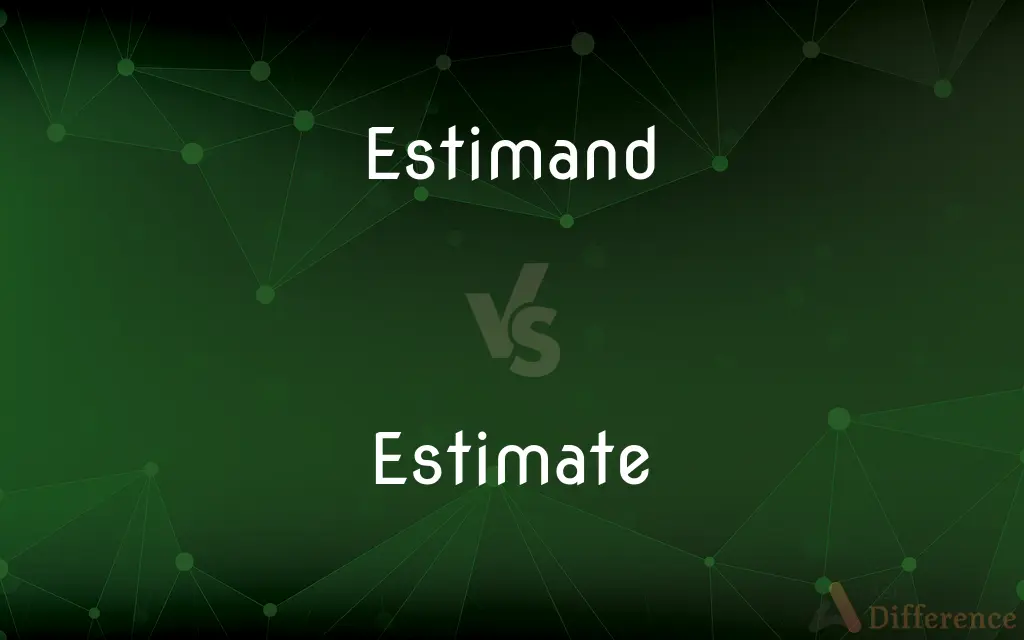Estimand vs. Estimate — What's the Difference?
Edited by Tayyaba Rehman — By Urooj Arif — Updated on April 7, 2024
Estimands focus on the specific quantity being estimated within a study, while estimates are the actual numerical results obtained from data analysis.

Difference Between Estimand and Estimate
Table of Contents
ADVERTISEMENT
Key Differences
Estimands are theoretical quantities defined in the study protocol that specify the target of the estimation process. They clarify what effect or difference is being measured, ensuring that research questions are precisely framed and aligned with the study's objectives. Estimates, on the other hand, are the numerical values derived from the analysis of collected data that aim to approximate the true value of the estimand. They provide the concrete results of statistical analyses, such as the mean difference between groups, odds ratios, or hazard ratios.
Estimands help to avoid ambiguity by detailing the exact aspect of the population or phenomena under investigation, which is crucial for study design and interpretation of results. While estimands define what is to be estimated, estimates deliver the actual measurements or calculations based on the sample data, which are used to make inferences about the population of interest.
Estimands require a clear conceptual understanding of the study’s objectives and are formulated before data collection. They are integral to the design phase, ensuring that the methodology is appropriately aligned to answer the research question. Estimates, however, are the outcome of the data analysis process. They are influenced by the sample size, data quality, and the statistical methods employed. As such, the accuracy and reliability of estimates depend on both the rigor of the study design and the appropriateness of the analytical methods used.
The concept of an estimand is broader and more abstract, focusing on the intention behind statistical analysis. It encompasses considerations like the target population, the effect of interest, and the conditions under which the effect is measured. Estimates, in contrast, are more concrete and specific, representing the application of statistical theory to the data at hand. They serve as the bridge between theoretical questions and empirical evidence, translating abstract concepts into quantifiable metrics that can be interpreted and acted upon in the context of the study’s objectives.
Comparison Chart
Definition
Theoretical quantity to be estimated defined in study protocol
Numerical result obtained from data analysis
ADVERTISEMENT
Role in Research
Specifies target of estimation to align with study objectives
Provides concrete results of statistical analyses
Importance in Study Design
Integral to design phase, ensuring methodology aligns with objectives
Outcome of data analysis, influenced by study design and methodology
Abstractness
Broader, more abstract concept focusing on intention behind analysis
More concrete, representing application of statistical theory
Dependency
Formulated before data collection based on study’s objectives
Dependent on sample size, data quality, and statistical methods
Compare with Definitions
Estimand
A theoretical construct that guides the selection of statistical methods and analyses.
Estimand for a study might involve the total effect of a drug, including both direct and mediated pathways.
Estimate
The calculated value approximating the true value of an estimand.
The estimated average difference in weight loss was 2.5 kg between diets.
Estimand
A parameter of interest in a statistical model that defines the specific effect to be estimated.
In a clinical trial, the difference in mean blood pressure reduction between the treatment and control groups is an estimand.
Estimate
The result of applying statistical methods to data to quantify an effect or association.
The hazard ratio estimate for the drug's effectiveness was 0.8.
Estimand
The precise quantity that researchers aim to estimate through statistical analysis.
The average impact of an educational program on test scores is an estimand.
Estimate
A numerical value derived from sample data as an approximation of a population parameter.
The estimate of the population mean IQ from a sample is 110.
Estimand
The outcome measure defined in the protocol of a study.
The proportion of patients achieving remission is an estimand in a psychiatric study.
Estimate
A specific measurement obtained from statistical analysis.
The estimate for the correlation between exercise and stress reduction was 0.45.
Estimand
The conceptual target of estimation in research studies.
In environmental science, the change in pollutant levels after a clean-up initiative is an estimand.
Estimate
The final numerical outcome of a statistical estimation process.
The point estimate of the survival rate at five years was 60%.
Estimand
An estimand is a quantity that is to be estimated in a statistical analysis. The term is used to more clearly distinguish the target of inference from the method used to obtain an approximation of this target (i.e., the estimator) and the specific value obtained from a given method and dataset (i.e., the estimate).
Estimate
To calculate approximately (the amount, extent, magnitude, position, or value of something).
Estimand
(statistics) that which is being estimated.
Estimate
To form an opinion about; evaluate
"While an author is yet living we estimate his powers by his worst performance" (Samuel Johnson).
Estimate
A tentative evaluation or rough calculation, as of worth, quantity, or size
An estimate of the damage caused by the storm.
Estimate
A statement of the approximate cost of work to be done, such as a building project or car repairs.
Estimate
A judgment based on one's impressions; an opinion
I have a high estimate of his character.
Estimate
A rough calculation or assessment of the value, size, or cost of something.
Estimate
(construction and business) A document (or verbal notification) specifying how much a job is likely to cost.
Estimate
An upper limitation on some positive quantity.
Estimate
To calculate roughly, often from imperfect data.
Estimate
To judge and form an opinion of the value of, from imperfect data.
Estimate
To judge and form an opinion of the value of, from imperfect data, - either the extrinsic (money), or intrinsic (moral), value; to fix the worth of roughly or in a general way; as, to estimate the value of goods or land; to estimate the worth or talents of a person.
It is by the weight of silver, and not the name of the piece, that men estimate commodities and exchange them.
It is always very difficult to estimate the age in which you are living.
Estimate
To from an opinion of, as to amount,, number, etc., from imperfect data, comparison, or experience; to make an estimate of; to calculate roughly; to rate; as, to estimate the cost of a trip, the number of feet in a piece of land.
Estimate
A valuing or rating by the mind, without actually measuring, weighing, or the like; rough or approximate calculation; as, an estimate of the cost of a building, or of the quantity of water in a pond.
Weigh success in a moral balance, and our whole estimate is changed.
No; dear as freedom is, and in my heart'sJust estimation prized above all price.
Estimate
An approximate calculation of quantity or degree or worth;
An estimate of what it would cost
A rough idea how long it would take
Estimate
A judgment of the qualities of something or somebody;
Many factors are involved in any estimate of human life
In my estimation the boy is innocent
Estimate
A document appraising the value of something (as for insurance or taxation)
Estimate
A statement indicating the likely cost of some job;
He got an estimate from the car repair shop
Estimate
The respect with which a person is held;
They had a high estimation of his ability
Estimate
Judge tentatively or form an estimate of (quantities or time);
I estimate this chicken to weigh three pounds
Estimate
Judge to be probable
Common Curiosities
Why is defining an estimand important in research?
Defining an estimand ensures clarity about what effect or parameter is being measured, aligning the study’s design, methodology, and analyses with its objectives.
Are estimands only relevant in clinical trials?
No, while commonly discussed in the context of clinical trials, estimands are relevant in any research study aiming to estimate a specific effect or parameter.
Can the estimate ever be exactly the same as the estimand?
In theory, an estimate can closely approximate the estimand, but due to sampling variability and measurement error, it is unlikely to be exactly the same.
How does the choice of estimand affect the analysis of a study?
The choice of estimand guides the selection of statistical methods and analyses, affecting how data are collected, analyzed, and interpreted.
What distinguishes an estimand from an estimate?
An estimand is the theoretical quantity defined to be estimated in a study, while an estimate is the actual numerical value obtained from data analysis that approximates the estimand.
How does sample size affect the estimate?
Larger sample sizes generally lead to more accurate estimates, reducing the impact of sampling variability.
Can there be multiple estimands in a single study?
Yes, a study can have multiple estimands if it aims to estimate several different effects or parameters.
Why might estimates vary between studies?
Estimates might vary due to differences in study populations, methodologies, sample sizes, or statistical analyses.
How do researchers determine the appropriate estimand for their study?
Researchers determine the estimand based on the study’s objectives, the research question, and the theoretical framework guiding the investigation.
What is the impact of data quality on estimates?
High-quality data lead to more reliable estimates, while poor data quality can bias the results and reduce the validity of the estimates.
How do researchers validate their estimates?
Researchers may use various methods such as cross-validation, comparison with known benchmarks, or replication studies to validate their estimates.
Can the same data lead to different estimates?
Yes, applying different statistical methods or models to the same data can result in different estimates.
What is the role of statistical methods in generating estimates?
Statistical methods apply mathematical models to the data to generate estimates that approximate the true value of the estimand.
Share Your Discovery

Previous Comparison
State vs. Society
Next Comparison
Dynein vs. KinesinAuthor Spotlight
Written by
Urooj ArifUrooj is a skilled content writer at Ask Difference, known for her exceptional ability to simplify complex topics into engaging and informative content. With a passion for research and a flair for clear, concise writing, she consistently delivers articles that resonate with our diverse audience.
Edited by
Tayyaba RehmanTayyaba Rehman is a distinguished writer, currently serving as a primary contributor to askdifference.com. As a researcher in semantics and etymology, Tayyaba's passion for the complexity of languages and their distinctions has found a perfect home on the platform. Tayyaba delves into the intricacies of language, distinguishing between commonly confused words and phrases, thereby providing clarity for readers worldwide.















































